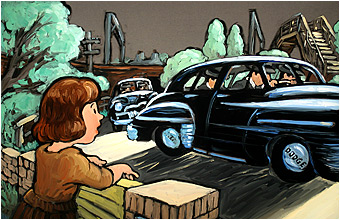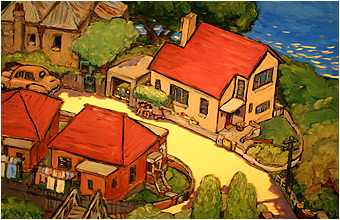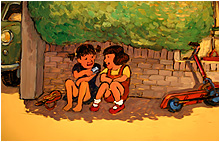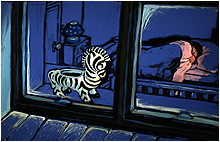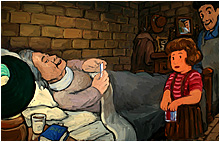THE SAFE HOUSE (26 mins. digital master, 2006)
Written, directed and animated by Lee Whitmore, THE SAFE HOUSE was produced by Film Australia for SBS. The film won Best Animation at the Yoram Gross/Sydney Film Festival and Australian Teachers of Media/ATOM Awards.
SYNOPSIS
THE SAFE HOUSE is the filmmaker’s true story of growing up during one of the most talked about events in Australian history - the real life spy drama known as the Petrov Affair.
It’s the summer of 1954 and seven year old Lee and her friends are drifting through the holidays, exploring their quiet suburban neighbourhood where nothing ever seems to happen… until one day mysterious strangers move in with the old lady next door. No one explains the odd comings and goings, the big black cars, the men in suits and hats, the overheard snippets of conversation. But that doesn’t stop the children from using their imaginations.
Lee makes sense of what she can, aided by half understood scraps of radio news and blurry photographs on the front pages of the newspaper. Only many years later did she learn that the strangers were Russian defectors in hiding from the KGB and in fear of their lives.
The film effortlessly evokes memories of childhood and a sense of a time passed, highlighting the fragility of the safe little world Lee once lived in innocent of the larger world as Australia was itself.
ANIMATION STYLE
I made THE SAFE HOUSE using artists’ oil paints and working with brushes on a glass surface. I discovered olive oil was good as a medium keeping the paint wet and workable for long hours. I worked directly under the camera, a process of continually painting ’in’, rubbing ‘out’ and repainting. For the first time I used a digital stills camera instead of a film camera. The digitised images were automatically transferred and stored in a computer. Using a computer gave me the opportunity for instant replay making it possible for me to create more complex straight ahead animation.
REVIEWS
THE SAFE HOUSE was screened recently on January 12th 2010 at 8.30 p.m. on SBS 2.
“This is a magical and luminescent stuff from a master animator – you’ve probably seen her work in ‘Breathing Under Water’ and ‘Looking for Alibrandi’.
The Safe House creates a seminal moment in Australian history as filtered through the eyes of a seven year old child, Lee Whitmore, in the summer of 1954.”
Doug Anderson
The Sydney Morning Herald
Tuesday, January 20th 2009
“Spy Drama Brought Home.
One of the relatively rare breed of Australian short animations made for children and adults.
The result is an alluring, fluid work lingering between the tangible and the hazily evocative global world of the child.”
Helen Crompton
West Australian
Tuesday, January 20th 2009
“The Petrov Affair: what the children saw.
One of the most intriguing stories from Australian political history has been told in the most unlikely fashion – through the eyes of children in an animated film.”
Whitmore created a traditional form of animation with digital technology to create a modern film with an old world feel.
Sally Bennett
Herald Sun – Melbourne
January 14th 2009
“The inspired animation of ‘The Safe House’.
The animation is faultless and a joy to watch.”
Paul Kalina
Green Guide’s Critics View
The Age
Tuesday, January 20th 2009
“An interesting look at the political intrigue and speculation surrounding the Petrov Affair, as seen from a child’s perspective, and beautifully rendered by Whitmore in oils.”
Leesha McKenny
The Guide, TV Previews
Sydney Morning Herald
January 19th-25th 2009
“What became known as the Petrov Affair – when soviet spies Evdokia and Vladimir Petrov defected Down Under, living in safe houses – is told through the recollections of a then seven year old child. Its artistic execution is amazing.”
Switched On
The Sunday Mail TV Guide – Brisbane
January 18th 2009
“Re-animating Australian History.
A luminescent re-creation of a pivotal moment in Australian history as experienced through a child’s eyes and ears.
The power of The Safe House resides in Whitmore’s consummate talent as an artist.
It’s a film for children and adults too, in which childhood, history, and politics come seamlessly together, a rarity in Australia film.”
Kieth Gallasch
Real Time, On Screen
August/September 2006





